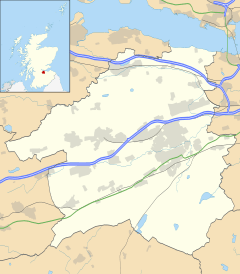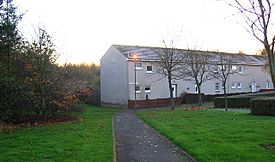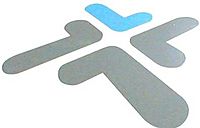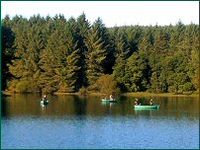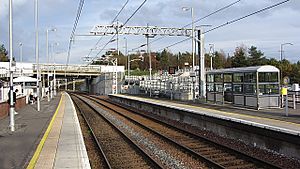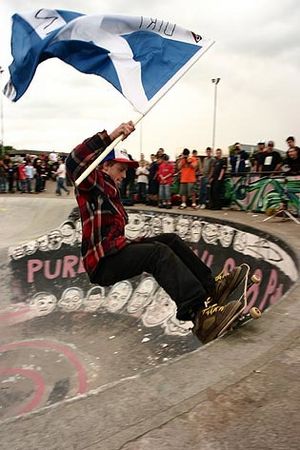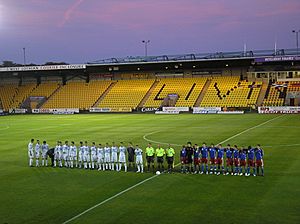Livingston, West Lothian facts for kids
Quick facts for kids Livingston
|
|
|---|---|
| New town and administrative centre | |
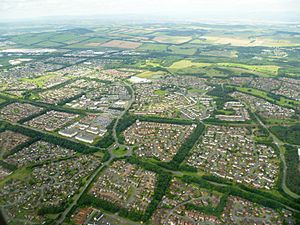 Aerial view of the north west of the town |
|
| Population | 56,840 (2020) |
| Language | English, Scots |
| OS grid reference | NT054690 |
| • Edinburgh | 14 mi (23 km) ENE |
| • London | 321 mi (517 km) SSE |
| Council area | |
| Lieutenancy area | |
| Country | Scotland |
| Sovereign state | United Kingdom |
| Post town | LIVINGSTON |
| Postcode district | EH53, EH54 |
| Dialling code | 01506 |
| Police | Lothian and Borders |
| Fire | Lothian and Borders |
| Ambulance | Scottish |
| EU Parliament | Scotland |
| UK Parliament |
|
| Scottish Parliament |
|
Livingston (Scots: Leivinstoun, Scottish Gaelic: Baile Dhunlèibhe) is the largest town in West Lothian, Scotland. Designated in 1962, it is the fourth post-war new town to be built in Scotland. Taking its name from a village of the same name incorporated into the new town, it was originally developed in the then-counties of Midlothian and West Lothian. It is situated approximately fifteen miles (25 km) west of Edinburgh and thirty miles (50 km) east of Glasgow, and is close to the towns of Broxburn to the north-east and Bathgate to the north-west.
The town was built around a collection of small villages, Livingston Village, Bellsquarry, and Livingston Station (now part of Deans). The town has a number of residential areas. These include Craigshill, Howden, Ladywell, Knightsridge, Deans, Dedridge, Murieston, Almondvale, Eliburn, Kirkton, and Adambrae. There are several large industrial estates in Livingston, including Houston industrial estate, Brucefield Industrial Estate, Alba Business Park, and Kirkton Campus. The locality of Livingston as defined by the General Register Office for Scotland (GROS) includes Uphall Station and Pumpherston. The wider urban settlement, also as defined by the GROS, also includes Mid Calder and East Calder. Other neighbouring villages include: Kirknewton, Polbeth and West Calder. The 2001 UK Census reported that the town had a population of 50,826. The 2011 UK Census showed the population of Livingston had increased to 56,269. Livingston is the second-largest settlement in the Lothians after Edinburgh.
Contents
History
Before 1962
The area around Livingston was previously an important shale oil area, the world's first oil boom occurred in West Lothian. This was based on oil extracted from shale, and by 1870 over 3 million tons of shale were being mined each year in the area around Livingston. Output declined with the discovery of liquid oil reserves around the world in the early 1900s, but shale mining only finally ceased in 1962. The "bings" that characterise oil shale mining in West Lothian have largely been flattened.
In 1898 Livingston had several houses, a Church of Scotland church, a United Free church and a school. Around 1 mile north of Livingston there was a railway station in a settlement called Livingston Station which is now part of Deans.
The old part of Livingston is now called Livingston Village.
New Town
Livingston was built as part of the New Towns Act of 1946, in part to ease overcrowding in Glasgow. Livingston was the fourth new town of five. The others were East Kilbride, Glenrothes, Cumbernauld and Irvine. Livingston was designated as a New Town on 16 April 1962. The first people moved into Livingston in April 1966.
Three villages (Livingston Village and Livingston Station in the old parish of Livingston and Bellsquarry in the parish of Mid Calder) and numerous farmsteads remain islands of old buildings within the new developments.
In 1984 Livingston gained its first railway station on the Shotts Line called Livingston South which was followed by Livingston North on the Edinburgh to Bathgate Line in 1986. These stations replaced the former Livingston and Newpark stations which had closed before the construction of the town.
In 1995 Livingston gained its professional football team, Livingston F.C. which was essentially the relocation of Meadowbank Thistle F.C. from Edinburgh.
Livingston Development Corporation
In order to build, manage and promote Livingston a quango organisation was formed, the Livingston Development Corporation.
The corporation guided Livingston until its mandate expired on 22 March 1997 and the town was transferred to West Lothian Council. The last major construction operation carried out by the LDC was the Almondvale Stadium, which was to become the home to the renamed Livingston F.C. A new purpose built campus for West Lothian College and other major developments have also taken place in Livingston over the last 10 years.
Construction in Livingston has continued under the management of West Lothian Council.
In 1979, an employee of the LDC claimed he was knocked unconscious after an alleged conflict with activities from a UFO. Robert Taylor, who was in his sixties at this point in time, was working as a Forester for Livingston Development Corporation near Dechmont Law when the supposed incident took place. The incident was reported to the police, but nearly 40 years after taking place, the incident has never been resolved. It remains one of the UK's most notable claimed UFO sightings.
Geography
Livingston is the 7th largest settlement and the 3rd largest town in Scotland, it is also the 171st largest settlement in the United Kingdom. It lies 30 miles away from Glasgow and 15 miles from Edinburgh.
 |
Falkirk (19km), Bathgate (8km) | Linlithgow (10km) | Broxburn (5km) |  |
| Glasgow (46km), Airdrie (27km) | Edinburgh (21km) | |||
| West Calder (6km), Shotts (19km) Lanark (31km) | The Borders, Harburn | East Calder (3km) |
Districts
The districts which make up Livingston include:
- Craigshill
- Howden
- Ladywell
- Knightsridge
- Deans
- Dedridge
- Murieston
- Almondvale
- Eliburn
- Kirkton (including Livingston Village)
- Adambrae
- Bellsquarry
Employment
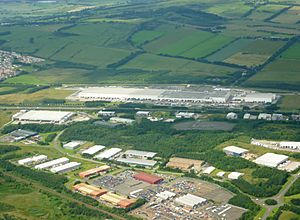
The area where Livingston now sits was historically dominated by oil shale mining, which is evident from the bings which still exist on much of the surrounding landscape. The designation of Livingston in the 1960s attracted new light industries to the area, with high technology and pharmaceutical companies moving into the town. Livingston formed a major hub in Scotland's Silicon Glen. Like most other areas this went into a slow decline with the closures of companies including Motorola and NEC. Several multi-national companies still have factories in the town. Sky UK is the largest private sector employer in West Lothian with a range of offices and contact centres. Other large employers include those in the retail sector and in the health care sector the National Health Service, Q Squared Solutions and Quintiles IMS.Witherby Seamanship, established in 1740, is one of the oldest publishers in the United Kingdom. Their offices and warehouse is located in Livingston.
Transport
Road
Livingston has excellent connections to the central Scotland road network: the M8 bounds Livingston in the north and the A71 in the south; The A899 dual carriageway spine road passes north south along Livingston's eastern edge and connects the two; The A89 runs east west on the north side of the M8.
Buses
Livingston has a central bus terminal with 7 stances located on Almondvale Avenue between the two shopping centres in the town centre. This provides regular services to surrounding towns and villages. First Scotland East and Lothian Country Buses are the main bus operator in Livingston. Other operators include E&M Horsburgh, Blue Bus, SD Travel, and Stagecoach. Livingston has buses to Edinburgh, Glasgow, Edinburgh Royal Infirmary, Lanark, Fife, Falkirk, and most West Lothian towns and villages.
Walking / cycling
Livingston has an excellent 'core path network' which is shared use, and available to pedestrians and cyclists. It connects all of the main areas of the town with shopping and work areas. It is for the most part segregated from roads and uses an extensive network of under/over pass systems to keep pedestrians and cyclists away from motorised traffic.
Rail
Livingston has three railway stations; Livingston North, Livingston South and Uphall (on the eastern edge of Livingston).
Livingston North is located adjacent to the Carmondean Shopping Centre between Eliburn and Deans and is on the North Clyde Line. The station opened on 24 March 1986, concurrent with the re-introduction of passenger services on the Edinburgh to Bathgate Line. On 12 December 2010, with the completion of the Airdrie-Bathgate Rail Link, Livingston North is now served by trains running to Glasgow Queen Street and Airdrie.
Livingston South is located at the Murieston Shops and is on the Shotts Line and has trains running between Glasgow Central and Edinburgh Waverley via Shotts. It was opened by British Rail on 6 October 1984.
Airports
Livingston is 7 miles (11 kilometres) west of Edinburgh Airport and 35+1⁄2 miles (57 kilometres) east of Glasgow Airport, both of which have regular flights to British and international destinations.
Culture and recreation
Youth activities
Livingston has its own Air Training Corps squadron, 2535 (Livingston) Squadron (located in Craigshill) and Army Cadet Force unit (based at Dedridge). The town also has Cubs, Scouts, Boys Brigade, Brownies and Guides units, and other organisations such as LGBT Youth Scotland and the Youth Action Project (WLYAP), and Firefly Youth Theatre (formerly West Lothian Youth Theatre) also operate in the area.
The youth action project involves a music session and many gigs and is widely attended by many teenagers from the surrounding area.
A leisure swimming pool and a Multiplex cinema are located in the town centre.
The Livingston Skatepark opened in 1981, at a time when most commercial skateparks were closing and was one of the most important facilities in Britain during a critical period in the development of skateboarding. It is an example of a free, unsupervised facility which achieved international status.
Sports
The town has a local cricket club, Livingston Cricket Club, a rugby union club, Livingston Rugby Football Club, a professional football club, Livingston F.C., and a junior football club, Livingston United.
Livingston is also home to; two competitive swimming clubs, the Livingston & District Dolphins and the Aquanauts of Livingston; Livingston and West Lothian Hockey Club, which has several men's and women's teams and provides junior coaching; West Lothian Wolves Basketball Club, with men and women's teams at all age groups and two track and field athletics clubs Livingston & District AAC, and Lothian RC.
Livingston FC
Livingston F.C., known to locals as "Livi" or "The Lions", are the most notable football team in the town. They were formed in 1995 on the relocation of Edinburgh-based side Meadowbank Thistle. The stadium opened in November 1995, but the Livingston name had already been adopted some months earlier when the club was still playing at its former home Meadowbank Stadium in Edinburgh.
Although they were playing in the Scottish Third Division in their first season in Livingston, six years later the club was promoted to the Scottish Premier League, finished third in their first season and qualifying for the UEFA Cup.
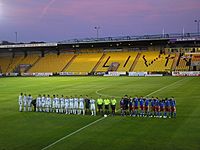
Relegation to the Scottish First Division in 2006 came after the club entered administration in 2004 as well as other financial problems. In 2009 they narrowly avoided going out of business and as a result were placed back in the Third Division.
The Lions managed to gain promotion to the Scottish Second Division the following year, and returned to the First Division after back to back league championships, on 6 August 2011. They currently compete in the third tier of Scottish Football
Livingston Cricket Club
Livingston also has a cricket club known as the Kingfishers which fields teams for juniors and seniors and has fielded professional paid players. The club plays in the East of Scotland Cricket Association and is based in Murieston.
Livingston Cricket Club was founded in 1981 by Dr Salem Patel and Doug Druce, playing its first match in August of that year in Armadale. The club joined the East League for the 1982 season, winning Grade D and promotion .
In 1983 the club came second to Kirkcaldy’s 2nd XI in Grade C which was enough to win election to Division 4 following league reconstruction. Home games that season were played at Bankton Mains in Murieston. The changing facilities were a wooden Wimpey hut which was eventually flame-grilled by local vandals at the second attempt.
With no changing facilities for 1984 all matches had to be played away from home while renovations took place at Bangour Hospital sports field to enable cricket to be played there for the first time since the 1950s.
The club remained at Bangour from 1985 to the end of the 1998 season.
By 1985 the increasing number of players enabled the club to start a 2nd XI which joined Grade D of the East League. The 1st XI remained in Division 4 until winning the league in 1992.
In 1994 sponsorship by the Livingston Development Corporation enabled the club to successfully negotiate the big step up to Division 2 where half of the clubs employed paid professional players. West Indian Mark Harper became the club’s first paid player and regularly set new batting records throughout the season. The creation of the National leagues in 1996 and the subsequent re-organisation of feeder leagues saw Livingston become a Division 1 club due to reconstruction of the East League. In 1999 we finished third, our highest league position to date. This coincided with a move back into Livingston to a large new ground in the Murieston area. Temporary pavilion facilities and the recent run of wet summers added to the fact that the ground is over 500 ft above sea level mean that Dresselrigg has yet to realise its full potential. Being almost in the foothills of the Pentlands, rainfall is heavier and the growing season considerably shorter than most of the other grounds in the Central Belt which causes major problems in getting the ground ready for play in April.
From May 2002 to August 2004 a concerted effort was made to source funding and construct a permanent pavilion. The Gerry Toms Pavilion was officially opened on 22 August 2004.
Religion
Christianity
Uniquely in Scotland, Livingston was from its formation designated an "Ecumenical Parish" in a joint initiative by the Church of Scotland, Scottish Episcopal Church, Methodist Church in Great Britain and the Congregational Union of Scotland (which subsequently united with the United Reformed Church). The Ecumenical Parish has six places of worship.
Apart from the Ecumenical Parish, Livingston Old Parish is a congregation solely within the Church of Scotland. There are also churches of other denominations, notably the Catholic Church, the Baptist Church (who have two congregations in Dedridge and Ladywell), Jehovah's Witnesses (who have two congregations: Livingston Deans and Livingston Dedridge) and the Free Church.
In Livingston there are three Catholic Churches. Saint Peters, in Carmondean, Saint Andrews in Craigshill, and St Philips in Dedridge.
Other religions
There is a mosque in the Craigshill area of the town called Livingston Mosque and Community Centre and also another within the Deans area.
Town twinnings
Livingston is twinned with:
 Hochsauerlandkreis, Germany.
Hochsauerlandkreis, Germany.
Primary sources
- Wills, E (1996) Livingston: the Making of a Scottish New Town
- Cowling, D (1997) An Essay for Today: the Scottish New Towns 1947-1997
http://www.westlothian.gov.uk/media/downloaddoc/1799479/Applying_for_a_House/Housingapplication2011
Economy

The area where Livingston now sits was historically dominated by oil shale mining, which is evident from the bings which still exist on much of the surrounding landscape. The designation of Livingston as a new town in the 1960s attracted new light industries to the area, with high technology and pharmaceutical companies moving into the town. Livingston formed a major hub in Scotland's Silicon Glen with factories constructed in purpose-build business parks at Houston Industrial Estate and Kirkton Campus. Like most other areas, this went into a slow decline from the late 1990s with companies including Motorola and NEC closing down their factories. Several multi-national companies still have factories in the town, including Wyman Gordon who manufacture aircraft components on the Houston Industrial Estate. Other companies on the Houston Industrial Estate include Mitsubishi Electric (who have an electric air conditioning factory which produces almost 150,000 air conditioning and heat pump units every year), Paterson Arran (a food manufacturer whose bakery, the Royal Burgh Bakery is located in Livingston), and DS Smith (who have a box production plant on the estate).
From the 1970s, Kirkton Campus on the western edge of the town was developed as Scotland's first technology science park. Developed for private businesses by the LDC, it included 300 acres of landscaped offices and factory sites along the Killandean Burn and River Almond. While several factories have since closed, it is still home to several businesses, including Sky UK who is one of the largest private sector employers in Livingston with a range of offices and their biggest UK contact centre at Kirkton Campus. Other companies at Kirkton Campus include Merck (a pharmaceutical company), Gore W L & Associates (a clothes manufacturer), SCION Instruments (a chromatography and gas detector manufacturer), JPT Foodtech, and Palletways (a distribution service which owns a 50,000-square-foot or 4,600-square-metre hub facility).
Other large employers include Tesco (whose distribution centre for Scotland and Northern Ireland is located on the northern edge of the town), Schuh (whose head office and customer service centre is on the Deans Industrial Estate in Livingston), Shin-Etsu Europe (who have a manufacturing facility in Livingston that produces semiconductors), those in the retail sector in the shopping centres, supermarkets, and the health care sector such as NHS Scotland. The Witherby Publishing Group, established in 1740, is one of the oldest publishers in the United Kingdom and their offices and warehouse is located in Livingston at Navigation House. Valneva SE is a biotech company that has a manufacturing facility in Livingston which produces vaccines, including a vaccine against COVID-19.
The Brucefield Industrial Estate is located west of Bellsquarry and includes companies such as Diet Chef (a food manufacturer), ScoMac (a catering equipment manufacturer), and Snag Tights (a textile manufacturer based in Livingston that exports to 90 countries).
Alba Business Park is located in Livingston to the west of Adambrae and includes a technology innovation centre. Companies in the Alba Business Park include Glenmorangie, the whisky distillers, who have offices and a bottling facility that was opened in 2011. Quintiles IMS, a healthcare data provider, have a large office in the business park. The prosthetic company Össur (Touch Bionics) has a research and development facility in the park.
Sport
The town has a local cricket club, Livingston Cricket Club; a rugby union club, Livingston Rugby Football Club; a professional football club, Livingston F.C.; and a East of Scotland League club, Livingston United.
Livingston is also home to; two competitive swimming clubs, the Livingston & District Dolphins and the Aquanauts of Livingston; Livingston Handball Club, Livingston and West Lothian Hockey Club, which has several men's and women's teams and provides junior coaching; West Lothian Wolves Basketball Club, with men and women's teams at all age groups; and two track and field athletics clubs, Livingston & District AAC and Lothian RC.
Livingston also has a number of youth football teams with the most successful being Murieston United who have teams ranging from the ages of under 9s to under 21s. They have some notable former players: Scott Arfield, Chris Innes, Derek Fleming, and Gary Wales.
Livingston FC
Livingston F.C., known to locals as "Livi" or "The Lions", are the most notable football team in the town. They were formed in 1995 on the relocation of Edinburgh-based side Meadowbank Thistle. The stadium opened in November 1995, but the Livingston name had already been adopted some months earlier when the club was still playing at its former home Meadowbank Stadium in Edinburgh.
Although they were playing in the Scottish Third Division in their first season in Livingston, six years later the club was promoted to the Scottish Premier League, finished third in their first season and qualifying for the UEFA Cup. Relegation to the Scottish First Division in 2006 came after the club entered administration in 2004 as well as other financial problems. In 2009 they narrowly avoided going out of business and as a result were placed back in the Third Division.
The Lions managed to gain promotion to the Scottish Second Division the following year, and returned to the First Division after back to back league championships, on 6 August 2011. They currently compete in the top tier of Scottish Football (Ladbrokes Premiership).
Swimming
Livingston has several swimming pools, the main pool being a 20m public pool run by West Lothian Leisure (Xcite). Other public pools are also located in local schools including Deans Community High School and Inveralmond High School and the Bannatyne Health Club has a private pool for members.
Livingston Cricket Club
Livingston has a cricket club known as the Kingfishers which fields teams for juniors and seniors and has fielded professional paid players. The club plays in the East of Scotland Cricket Association and is based in the Murieston area of Livingston. The Club was founded in 1981 by Dr Salem Patel and Doug Druce, playing its first match in August of that year in Armadale. The club joined the East League for the 1982 season, winning Grade D and promotion. The Club played at several locations in Livingston, including Bankton Mains and at Bangour Hospital sports field. The 1st XI remained in Division 4 until winning the league in 1992. In 1994 sponsorship by the Livingston Development Corporation enabled the club to successfully negotiate the big step up to Division 2 where half of the clubs employed paid professional players. West Indian Mark Harper became the club's first paid player and regularly set new batting records throughout the season. The creation of the National leagues in 1996 and the subsequent re-organisation of feeder leagues saw Livingston become a Division 1 club due to reconstruction of the East League. In 1999 the Club finished third, their highest league position to date. This coincided with a move back into Livingston to a large new ground in the Murieston area. Being almost in the foothills of the Pentlands, rainfall is heavier and the growing season considerably shorter than most of the other grounds in the Central Belt, which causes major problems in getting the ground ready for play in April. A new pavilion, the Gerry Toms Pavilion was officially opened on 22 August 2004.
Education and libraries
Livingston has 18 nursery schools, 17 primary schools, and five special schools. There are four secondary schools in the town which are Inveralmond Community High School, The James Young High School, St. Margaret's RC Academy and Deans Community High School.
West Lothian College offers higher and further education and its central campus is based in Livingston. The college has sports facilities, a library, a training restaurant for hospitality students (which was awarded Scottish Restaurant of the Year in 2015 and 2017), and a salon/spa. The college provides educational services to over 8,000 students a year and has 350 staff.
Livingston has three public libraries which are Almondbank Library in Craigshill, Lanthorn Library in Dedridge, and Carmondean Library in Deans. A local history library which includes items on the history of Livingston is located in nearby Linlithgow.
The Scotland Japanese School (スコットランド日本語補習授業校 Sukottorando Nihongo Hoshū Jugyō Kō), a weekend Japanese school, is held at St. Margaret's Academy in Livingston. It first opened in 1982 and moved to Livingston in April 2003.
Notable residents
Notable residents of Livingston include Robin Cook (the former MP for Livingston and Foreign Secretary from 1997 until 2001; died 2005) and Ian Colquhoun (author, born and educated in Livingston).
Actors, musicians and entertainers include Nina Nesbitt (singer songwriter) and David Cicero (singer/keyboardist and associate of the Pet Shop Boys who moved to Livingston as a child).
Livingston sports personalities include Craig Benson (Olympic swimmer and World junior men's breaststroke champion, born and educated in Livingston), Peter 'Snakebite' Wright (born in Livingston, PDC World darts champion), and Elise Christie (short track skater, who competed at the 2010 Winter Olympics and 2014 Winter Olympics). Livingston is the birthplace and home of several Scottish footplayers, including Scott Arfield (football player for Rangers F.C), Mark Burchill (footballer, educated in Livingston), Paul Dickov (former Arsenal player and former manager Doncaster Rovers from 2013 to 2015), James Penrice (professional footballer for Partick Thistle), David Robertson (footballer for St Johnstone F.C.), Jimmy Scoular (former Portsmouth FC and Newcastle Utd football player and Cardiff City manager), Gary Wales (former Hearts player, and Kilmarnock player), Tommy Walker (former Hearts and Chelsea player and manager for Hearts), Keith Watson (footballer, previously for Hartlepool United), and Danny Wilson (footballer, player for Rangers, Liverpool and a former Hearts captain).
Images for kids
-
Livingston old Kirk is one of the oldest buildings in Livingston, dating from 1732. It was part of the original Livingston village settlement.
See also
 In Spanish: Livingston para niños
In Spanish: Livingston para niños


